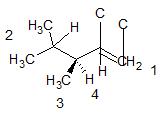I don't understand why this molecule is assigned S instead of R.

The H is assigned a priority of 4; the methyl group on the chiral carbon gets 3; the left carbon gets 1 and the right carbon gets 2. The rotation should therefore be clockwise.
I guess what I have an issue with is assigning priorities in cases like these: what does moving away from the chirality center mean? Do I choose the H? The C? The other C? 
Do we just ignore the attached hydrogens? It seems like the hydrogen on the carbon left of the chirality center is ignored.


And in the above case, why are we comparing an O with a C? The first atom to the left of the chirality center is a C, not an O.

And in the last picture I give my configuration for the molecule in the first picture. Why doesn't the upper right carbon have a priority of 2? Double bonded carbon counts twice; the rest are hydrogens.

